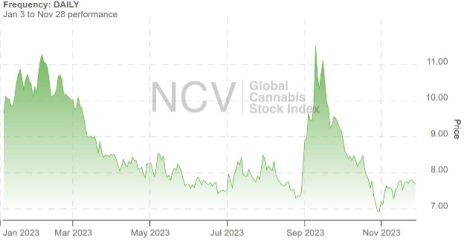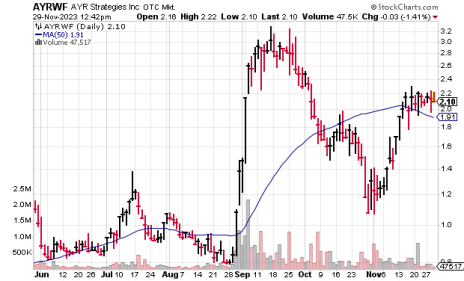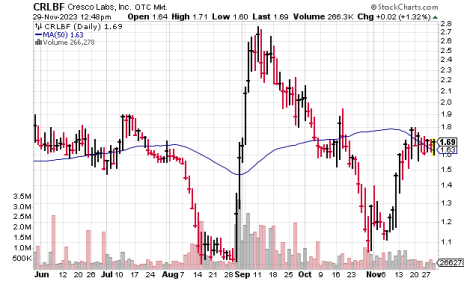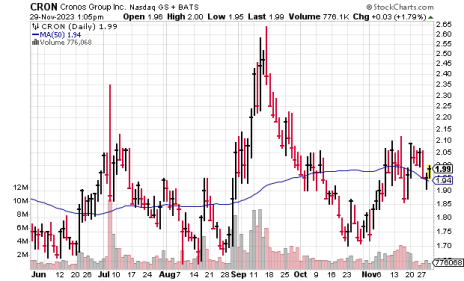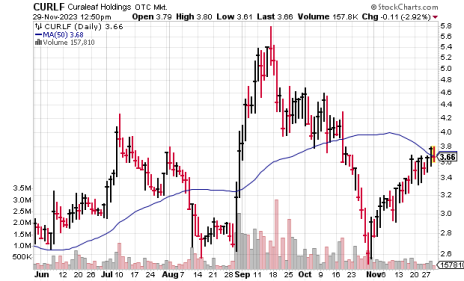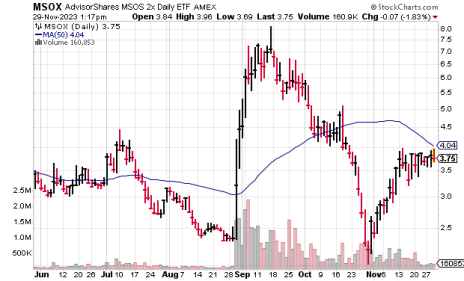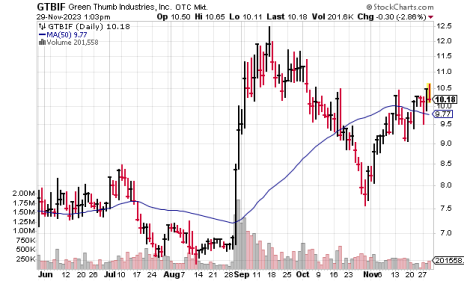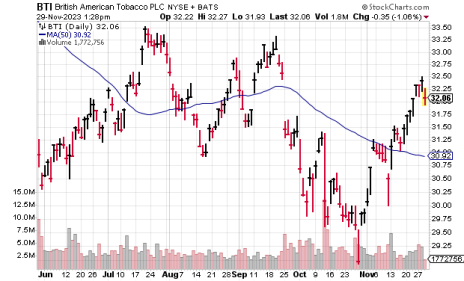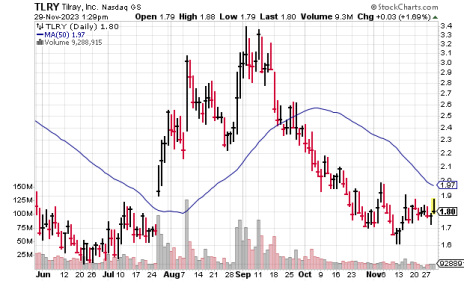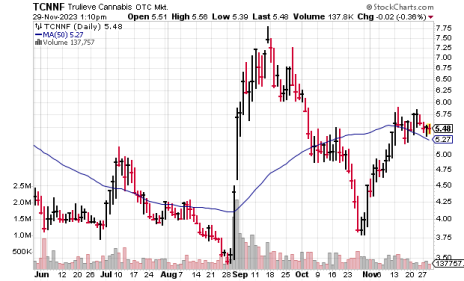Cabot Cannabis Investor has delivered several excellent trades in the past month.
* Back on October 31 I was very bullish on the cannabis group which was weak because of the nomination of Rep. Mike Johnson (R-LA) as House speaker. He has always opposed cannabis legislation. I argued there were several other catalysts in the mix regardless of how Congress acted on legal reforms. “Cannabis stocks are a strong buy in the weakness,” I wrote.
I suggested any of the names in our portfolio, or the AdvisorShares Pure U.S. Cannabis (MSOS) exchange-traded fund (ETF) and the leveraged version, AdvisorShares MSOS 2x Daily (MSOX), for simplicity. “I am adding to MSOS and MSOX in the weakness, and I will continue to add, particularly if they get weaker from here.” Since October 31, here’s how those trades have done:
MSOS is up 23.2%.
MSOX is up 46.9%.
* On November 8 I suggested staying long our portfolio names, singling out MSOS and MSOX for simplicity, despite the decent gains from October 31. “I suggest continuing to stay long in the midst of the overall weakness since that rescheduling news rally last summer.” Since then, here’s how the trades worked out:
MSOS is up 11.5%.
MSOX is up 20.9%.
* The Cabot Cannabis Investor cannabis stock portfolio is up 8.75% since October 25. This year, we are outperforming the New Cannabis Ventures Global Cannabis Stock Index by 8.9 percentage points.
* The covered calls I suggested selling against Canna Plus portfolio name Cerevel Therapeutics (CERE) on October 25 expired worthless, which means you got to keep all the premium minus commissions. This trade is now repeatable but with a higher strike price of $30 (more detail below).
What to Do now
Those were some nice trades, but what to do now? I suggest continuing to stay long and adding on any weakness of 2% to 4% or more, in any of our portfolio names.
Portfolio names are: Ayr Wellness (AYRWF), Cresco Labs (CRLBF), Curaleaf (CURLF), Cronos (CRON), AdvisorShares Pure U.S. Cannabis (MSOS), AdvisorShares MSOS 2X Daily (MSOX), ETFMG Alternative Harvest (MJ), Green Thumb (GTBIF), Organigram (OGI), Tilray Brands (TLRY), Trulieve (TCNNF) and Verano (VRNOF). For simplicity, consider getting exposure via MSOS or the leveraged version MSOX.
Here are four reasons why I suggest staying long and accumulating on weakness.
Reason #1: Cultural Momentum
There’s tremendous cultural momentum toward cannabis reform around the world, so it’s hard to believe cannabis stocks will remain ignored and disliked forever. It is tough to think that investors won’t come around in a big way on cannabis names – over the next six months to two years.
We see the powerful cultural momentum in the form of changes in laws, big investments by a large tobacco company, robust cannabis sales growth, poll results and election outcomes (all outlined in more detail below).
These trends tell us cannabis stocks are a strong contrarian buy now that will turn very profitable for patient investors with a medium-term horizon. But there are also some possible robust near-term catalysts for traders, like rescheduling news.
Reason #2: Rescheduling News
Cannabis stocks nearly doubled last summer beginning in late August when we learned that the Department of Health and Human Services (HHS) recommended the rescheduling cannabis under the Controlled Substances Act (CSA). HHS recommended cannabis be moved to Schedule III from Schedule I. The change would help cannabis companies by allowing them to deduct expenses against income in federal tax returns.
The next step in this process will be the publication of a proposed rule on rescheduling by the Drug Enforcement Administration (DEA). Consensus holds this will happen by year end. “From a timing perspective there’s flexibility, but all indications and what we’re hearing and seeing from other reports is by the end of the year,” says Cresco Labs (CRLBF) CEO Charlie Bachtell. He doesn’t think the foot dragging on reform by politicians or conservative House speaker will be an issue. “There’s a difference between legislation and administrative action. Administrative action like a rescheduling is somewhat more insulated from the complexities and risks associated with legislation. So, I feel good about it.”
The Congressional Research Service (CRS) says the DEA is likely to go along with the HHS recommendation, given its track record of nearly always doing so in the past.
The bottom line: This will be a meaningful catalyst for cannabis stocks. It could send them back up to near the levels they hit on the HHS news last summer.
After a rule is published, there will be a comment period lasting two months or more. Then the Department of Justice (which houses the DEA) will issue a final rule. Cannabis sector analysts say this could happen by spring, or summer at the latest (see below, for analysis by cannabis sector regulatory attorney and former cannabis policy maker at the Food and Drug Administration).
Reason #3: SAFER Banking
The Senate banking committee approved the Secure and Fair Enforcement Regulation (SAFER) Banking Act on September 27. This is a bill that would allow federally regulated banks access to the cannabis industry.
The issue has dropped off the radar screen, but it could come back if the bill gets voted on by the Senate and included in “must pass” legislation. Both are possible, but tough to predict with certainty.
A recent survey paid for by the American Bankers Association (which wants SAFER approved because it would create new business for banks) found that 55% of Americans say they want Congress to pass a law allowing banks to serve cannabis companies in states where marijuana is legal. A similar survey in 2022 found that 66% of people support this.
Reason #4: More Progress on State-Level Reform
Ohioans just voted to legalize recreational use. This puts pressure on Pennsylvania which has been toying with legalization of rec use, especially now that the state is virtually surrounded by states that have legalized (see below). Florida is circling the legalization of rec use, via a potential referendum vote in 2024. Neither state will legalize over the next six months. But there could be significant progress in either state in that time frame, which would be a catalyst for the group.
Now, here’s a look at the developments supporting the ongoing cultural momentum towards cannabis reform, both in the U.S. and around the world. I try to document the cultural momentum each issue because it is so important to understand, when considering the case for investing in the sector.
Cannabis News From Around the Country
Support for legal cannabis has reached a clear tipping point in the U.S. which has bullish implications for cannabis stocks. Following approval by Ohioans of recreational use, 53% of people in the U.S. live in a state that allows recreational use. Almost 75% live in a state that has legalized medical or recreational cannabis. Ohio became the 24th state to allow recreational use, and 38 states plus Washington, D.C., permit medical use.
Importantly, a recent Gallup poll found that a record 70% of Americans support the legalization of recreational use. A former Food and Drug Administration cannabis policy expert predicts rescheduling by the summer. That will be a huge catalyst for the group, if he turns out to be right. Meanwhile, institutional investors love cannabis stocks, but only so much.
Here’s more detail on these and other developments in the past few weeks confirming the cultural momentum behind cannabis reform in the U.S. and around the globe – reform that that is bullish for cannabis stocks.
* A former Food and Drug Administration (FDA) cannabis policy official says he’d be surprised if the Drug Enforcement Administration (DEA) didn’t reschedule marijuana by next year’s presidential election.
The change would be a huge catalyst for cannabis stocks.
“I would be really shocked if it took the DEA longer than the second quarter of next year to come up with its final rule,” said Howard Sklamberg, who was the head of the FDA’s Marijuana Working Group during 2014-2017. “Even when I was at the FDA, we knew that important regulations that you wanted to get done in an election year, you want to get done by the summer before the election.”
Sklamberg expects DEA to accept the Department of Health and Human Services (HHS) recommendation to put cannabis in Schedule III of the Controlled Substances Act (CSA), down from Schedule I. “It certainly would be strange, in an issue that is such an important priority for the administration, for one part of the administration to reverse what another one has said,” said Sklamberg during a cannabis sector webinar earlier this month. Sklamberg is an attorney at the firm Arnold and Porter. He made the comments during an American Trade Association for Cannabis and Hemp’s (ATACH) Capital Markets Council webinar.
The Congressional Research Service (CRS) has also said it is likely that the DEA would follow the HHS recommendation based on precedent, but unlike Sklamberg it does not offer a timeline.
Rescheduling to Schedule III could be huge for cannabis companies because it would exempt them from an Internal Revenue Service (IRS) rule that prohibits cannabis companies from deducting operating expenses. Because of the rule, called 280E, cannabis companies pay a 70% tax rate.
Sklamberg also rejected the theory that rescheduling would be a negative because it would increase FDA oversight and enforcement of cannabis sales.
* A recent Gallup poll found that around 70% of Americans support cannabis legalization, the highest level since Gallup began doing surveys on the topic in 1969. Back then, only 12% wanted legalization. Importantly, the poll found that a sizable majority of Republicans are on board with the reform. This matters, because historically Republican lawmakers have been the most likely to oppose reform.
“More than ever, cannabis continues to break down the partisan barriers as U.S. voters are saying they want to create a responsible and regulated cannabis industry,” said Cresco Labs (CRLBF) CEO Charles Bachtell, in his most recent earnings call. “And while the timing of federal reform has been unpredictable, we’ve reached a tipping point where change is inevitable.”
A majority of men and women and all age groups support reform, Gallup found. There’s also majority support for reform across all races and education levels.
“The nation has reached a broad consensus on legalizing marijuana,” says Gallup. “Not only do most U.S. adults favor it, but so do majorities of all major political and ideological subgroups. The high level of support among younger adults suggests national backing will only expand in the years ahead, likely resulting in more states, and perhaps the federal government, moving to legalize it.”
The poll found that 79% of people 18-34 years old back legalization. It found 71% of people 34-54 and 64% of people 55 and older support reform. Democrats were most likely to support legalization (87%), followed by independents (69%) and Republicans (55%). Support among Republicans increased by four percentage points since 2022. The highest level of support for legal cannabis is in the Midwest at 75%, followed by 72% support in the West, 70% in the South and 64% in the East.
The poll also found that 50% of Americans say they have tried cannabis, and 17% of American say they currently use. The poll was conducted during October 2-23.
* Institutional investors are increasingly bullish on U.S. cannabis companies, but they aren’t putting their money behind their outlook just yet.
That’s the conclusion of a recent survey by ATB Capital Markets which is based in Calgary, Alberta. The report polled 23 institutional investors, mostly hedge funds, in late October. They are more bullish than they were six months ago, mostly because of the potential for rescheduling at the federal level in the U.S., said Frederico Gomes, a cannabis equity analyst at ATB. The respondents said they see a 75% chance that the U.S. government will move cannabis to Schedule III from Schedule I within the next 18 months.
About 61% of the respondents expect U.S. multistate cannabis companies will beat the S&P 500 over the next year. Despite the bullish outlook, most of the respondents reported no change or a decrease in exposure to U.S. multistate operators in the past six months. This suggests the investors are waiting for a U.S. Drug Enforcement Administration rescheduling recommendation, having been burned by false hopes for federal-level reform several times in recent years, the report says.
Respondents put the odds at 50% for Congressional approval of the SAFER Banking Act, which would allow banks to do business with cannabis companies.
Respondents said rescheduling was the most important potential catalyst, while uplisting to the Toronto Stock Exchange is the least important factor in their investment thinking.
About 60% said they expect Canadian producers and retailers to underperform the S&P 500 over the next year, citing poor operating results and shareholder dilution. “Canadian cannabis bulls are close to extinction, which could mark a bottom in the sector,” says the report.
* Pennsylvania Gov. Josh Shapiro (D) says the Ohio voter approval of recreational use sales is “another reminder” of the need to enact reform in his state. Five out of six bordering states now permit recreational use sales. They are Delaware, Maryland, New Jersey, New York and Ohio. Shapiro supported legalization in his most recent campaign. But reform efforts have stalled in the legislature. Democrats control the House, and Republicans (who are more likely to oppose legalization) have a majority in the Senate.
Sen. Sharif Street (D), who is sponsoring a legalization bill with Sen. Dan Laughlin (R), is “cautiously optimistic Pennsylvania will get it done in 2024.” Since the state is surrounded by states with legal sales, going legal in Pennsylvania would not really increase accessibility, but it would create more tax revenue, he reasons. “I don’t know how much longer Pennsylvania can continue to ignore what I consider to be the obvious,” said Laughlin.
About half of the state’s residents live in a county that borders on a state that has legalized rec-use sales. West Virginia is the only state bordering Pennsylvania that has not legalized recreational use.
* Price compression, which has plagued the sector, may be coming to an end. Here is one CEO’s comments on price stabilization. “Last quarter, we began seeing green shoots, and those green shoots continue to emerge in the third quarter,” said Curaleaf (CURLF) CEO Matt Darin in the company’s Q3 earnings call. “In fact, pricing in our retail stores was up in ten of our states compared to four last quarter. While there continued to be reasons to be cautious, both geopolitically and industry specific, we are optimistic that price declines appear to have bottomed last quarter, boding well for the fourth quarter.”
* Ohio lawmakers are working on reforms to a recent voter-approved recreational-use legalization law, but the changes will be modest. Changes might limit advertising and public consumption and loosen licensing preferences for people who have been convicted of selling drugs. The governor has said any revisions will honor the “spirit” of the legalization referendum.
Consumers continue to vote with their wallets
* Michigan cannabis tax revenue grew 49% in the past year, surpassing taxes netted from alcohol sales. Cannabis sales brought in $266.2 million in tax revenue in the most recent year, says the state’s House Fiscal Agency. That’s more than the state made from the sale of beer, wine and liquor combined. The state taxes recreational-use cannabis at 10%, and buyers also pay the state’s 6% sales tax. The cannabis tax take is about 1.3% of total state revenue. Alcohol taxes brought in $192.6 million. Michigan started legal recreational-use sales in 2019. The cannabis tax take has continued to grow despite plummeting cannabis prices in the past year. An ounce of cannabis costs under $100, compared to $180 at the end of 2021. Cannabis brings in more tax revenue than alcohol does in Illinois, Colorado, Arizona and Washington. Michigan recently ended pre-employment marijuana testing for most government employees.
* Missouri cannabis retailers sold about $95.5 million worth of recreational-use products in October, and $17.6 million in medical marijuana. Both were slightly lower than the month before, but they took total sales for the year to more than $1.1 billion. Recreational sales began in February.
* Maryland dispensaries sold a record amount of recreational-use cannabis in October. Overall sales fell slightly to $90 million from the month before, but recreational-use sales posted record sales since they commenced in July, at $55 million.
* Overall cannabis sales in Connecticut during October fell slightly to just under $25 million. But recreational-use sales hit another monthly record, at $14.7 million. Recreational-use sales have come in at record levels every month since approved in January. Average cannabis prices fell again, but only slightly. This confirms a possible end to the precipitous declines of the past 18 months that have haunted cannabis companies and reinforces my take that the sector is a strong buy here. Connecticut legalized recreational use in 2021, and sales commenced in January, this year.
Ongoing progress on legalization
* South Dakota cannabis advocates have launched a voter initiative to legalize recreational use. The proposed referendum needs 17,500 signatures to pass. The proposal would allow the state health department to issue dual-use licenses to medical marijuana dispensaries to sell recreational-use cannabis products. The state has allowed medical-use sales since July 2022.
* New York marijuana regulators have approved lawsuit settlements that could allow hundreds of cannabis businesses that have been blocked to finally open their doors. One suit argued the prioritization of social equity applicants unfairly omitted disabled veterans from the eligibility pool. Another suit argued that legal medical marijuana businesses should qualify for licensing for recreational sales immediately. The settlement still has to be approved by the state Supreme Court.
There are only about two dozen licensed marijuana retailers in the state but hundreds of illegal stores. The state recently approved legislation that makes it easier for financial institutions to work with cannabis businesses, as well as a New York City exemption to IRS rule 280E which blocks cannabis company expense deductions at the federal level. That carve out was already in place for the rest of the state.
* In an interview with Yahoo News, Senate Majority Leader Chuck Schumer (D-NY) said the Senate is “getting close” to passing cannabis sector banking reform known as the Secure and Fair Enforcement Regulation (SAFER) Banking Act. Schumer’s past predictions about progress have turned out to be wrong, and the reform faces significant challenges in the House. Cannabis investors are rightly skeptical of anything Schumer says because he has let them down in the past. So, take it with a grain of salt.
* Minnesota could start accepting applications for recreational-use dispensaries in the fourth quarter of 2024 and launch sales the following year, says a cannabis regulator in the state.
* Young adults in California significantly reduced their use of alcohol and cigarettes after the legalization of recreational-use cannabis, according to a recent study. The 18-20-year-old also demographic did not use more cannabis, after legalization.
The study also found that the use of illicit and prescription drugs did not significantly change, refuting the “gateway drug” theory of cannabis legalization. The findings suggest the “possibility of a protective effect offered by cannabis, including edibles, or potentially ongoing changes in norms and attitudes toward these substances within this socio-historical context.”
The study was published in the Journal of Psychoactive Drugs. It was funded by the National Institute on Drug Abuse.
* Minnesota is launching a pilot program to explore the use of a saliva-based roadside cannabis impairment test. The test will screen for six different compounds, including cannabis and opioids. The state is using the SoToxa Oral Fluid Mobile Analyzer and the Drager DrugTest 5000 in the pilot program. Users won’t face legal consequences in the pilot program.
International progress
* German lawmakers have tweaked a marijuana legalization bill, accommodating cannabis reform advocates who challenged some parts of the proposed law. The changes relax some provisions on topics like jail time for possession of amounts beyond the legal limit, limits on home grow, and consumption near schools. The changes come ahead of a possible finial vote in the German parliament next week. The bill will then be considered the Bundesrat, which represents German states.
* A United Nations commission has removed cannabis from the body’s “most dangerous drug” category. The change acknowledges that cannabis has medical uses. The U.N. Commission on Narcotic Drugs approved a World Health Organization recommendation to remove cannabis from its Schedule IV classification under the 1961 Single Convention on Narcotic Drugs. That categorization put cannabis in the same category as heroin. Under the U.N. classification system, Schedule IV drugs are a subset of Schedule I. That means they are “highly addictive and highly liable for abuse” and of “extremely limited medical or therapeutic value.” Cannabis remains in the U.N. Schedule I category.
* A senate committee in Colombia has approved a bill to legalize cannabis. The country’s equivalent of the House of Representatives has already approved the bill.
* The National Assembly of lawmakers in South Africa have approved a bill to legalize cannabis possession and cultivation. The bill next goes to the country’s National Council of Provinces. The reforms do not legalize sales. Users would have to grow their own.
* Japanese legislators recently approved a bill to legalize medical products made from cannabis, including Epidiolex, which contains cannabidiol, approved in the U.S. and Europe to treat epilepsy. A clinical trial of the drug is underway in Japan. The drug is sold by GW Pharmaceuticals, a British company, which is conducting the clinical trial. Cannabis use remains illegal in Japan.
* About a third of Canada’s indoor cannabis cultivation capacity has been taken offline in the past three years. Capacity shrinkage is bullish for cannabis stocks since it eases the oversupply that has put severe downward pressure on prices over the past 18 months. Health Canada says there was 16.3 million square feet of cultivation capacity in March 2023, down from 23.9 million square feet in mid-2020. Canadian capacity expanded sharply during the sector’s 2017-2020 boom.
Cannabis Portfolio Company News
Big picture, our companies continue to position themselves in the best markets, or the ones that may soon see rapid growth because of legalization efforts. They continue to exit weaker markets like California, Oregon and Arizona, and cut costs to boost cash flow and shore up their balance sheets in these trying times of price compression for the sector. (Price compression may now be easing.) This is exactly what we want them to do, and it is encouraging to see the progress.
Ayr Wellness (AYRWF)
Ayr Wellness reported 5% third-quarter sales growth compared to the year before, excluding discontinued operations, which means the sale of its Arizona business last March. But sales declined slightly compared to the second quarter, as prices fell and the company faced cultivation issues in Florida, meaning an equipment failure that caused overheating at a grow site.
The company reported $20 million in operating cash flow and a sharp 92% reduction in losses to only $1.5 million. Adjusted EBITDA, which you have to take with a grain of salt because of the adjustments, advanced 52% to $28.4 million. The company reported the results on November 16.
Ayr said it is making progress on extending the maturities on $400 million of debt by two years. The change will mean Ayr Wellness will have no meaningful debt maturities until 2026.
Retail transactions in the third quarter were up 18% on a same-store basis, driven by customer acquisition and Ayr’s customer loyalty program. This increase was offset by continued pricing pressure and a hit to Florida inventory due to the “temporary cultivation challenges” caused by equipment failure. This issue will hurt fourth-quarter sales, too. The company guided for flat sequential growth in the fourth quarter, and flat second-half growth compared to the first half. Florida is a forced vertical integration state, so sellers are reliant on what they can grow themselves.
Ayr Wellness is well positioned in Ohio, where voters just approved recreational-use legalization, and Pennsylvania and Florida, which seem poised to legalize rec use over the next two years. The company has opened 10 stores in Florida this year, bringing the total there to 62. It only has three dispensaries in Ohio, but it has a big cultivation facility there. It has nine dispensaries in Pennsylvania. Converting its medical-use stores in those states to recreational use would increase its rec-use retail footprint six-fold. That would be a big deal, for the company and its investors.
Cresco Labs (CRLBF)
Cresco Labs reported $191 million in revenue for the third quarter, a 9.5% decline compared to the year before, and a 3.7% sequential decline. The declines were caused by lower wholesale revenue related to a scaling down of business in California and Maryland. Retail revenue grew 2% as the company opened two new stores and saw continued market share improvement. Retail transactions grew 17% to 1.4 million.
The company continued to cut costs, $40 million so far this year, supporting big sequential gains in operating cash flow to $41 million (almost twice the total for the first two quarters), and a 21% sequential gain in adjusted EBITDA to $49 million. Cresco closed the quarter with $113 million in cash.
The company guided for a mid-single-digit sequential sales decline in the fourth quarter. Gains from new stores in Florida and Pennsylvania will be offset by its exit from its Arizona business and expected seasonal weakness. The company opened two Sunnyside stores in Florida, bringing the nationwide store count to 70.
Cresco is exiting California and Arizona in favor of Ohio, which just legalized recreational use. It is also favoring two big states which look poised to do so, Florida (12 new stores this year), and Pennsylvania (three new stores this year). Cresco also has a strong position in Illinois. Cresco has the number one share position in Illinois, Pennsylvania, and Massachusetts. It has the most popular portfolio of branded flower and branded concentrates in the country, and the fourth most popular portfolio of branded vapes and edibles.
Curaleaf (CURLF)
Curaleaf reported third-quarter revenue of $333 million, a 2% increase over the prior year but a 1% decline sequentially.
Operating cash flow from continuing operations came in at $47 million and free cash flow was $33 million. Curaleaf reported adjusted EBITDA of $75 million. It ended the quarter with $118 million in cash.
The company has cut $90 million in annualized expenses in the past twelve months. It reported net losses of $92.3 million or 13 cents a share.
The company opened two stores in Connecticut and expanded its European business by commencing sales in Poland. It signed a deal to sell its Oregon assets, and it continued to scale back production in Nevada.
“With significant near-term state and regulatory catalysts on the horizon, coupled with our proposed uplisting to the Toronto Stock Exchange and our early mover advantage in Europe give us great confidence in Curaleaf’s future,” said board chair Boris Jordan.
“The growth catalysts of Germany, New York, Ohio, and potentially Florida and Pennsylvania position Curaleaf incredibly well for years of market share gains,” said CEO Matt Darin. “While European cannabis is still in the early days of development, no competitor has our distribution platform, scale cultivation facilities, suite of branded products. We continue building out the full breadth of our European supply chain to meet increasing demand for higher-quality products in both large markets like the U.K., Germany and Poland, as well as smaller markets like Switzerland.”
Curaleaf expects slight Q4 sales growth to help it finish 2023 with 5% sales growth for the year.
Green Thumb (GTBIF)
Green Thumb reported third-quarter revenue of $275 million, up 5.4% over the prior year, and a 9% sequential increase. The gains came mostly from the launch of recreational-use sales in Maryland and store openings. The company reported net income of $11 million, or $0.05 per share.
It reported third-quarter operating cash flow of $61 million and adjusted EBITDA of $83 million. The company ended the quarter with $137 million in cash. It repurchased $25 million worth of shares, or over 1% of shares outstanding. The company opened RISE Dispensaries in Las Vegas, Nevada, and Fruitland Park, Florida. After the quarter ended, it opened three RISE Dispensaries in Florida.
Trulieve (TCNNF)
Trulieve reported $275.2 million in third-quarter sales, an 8.5% decline over the prior year. The company reported a net loss of $25 million, or eight cents per share.
The company posted decent cash flow gains. It generated operating cash flow of $93 million, free cash flow of $87 million and adjusted EBITDA of $74 million. It used the cash to reduce debt by purchasing $57 million worth of 2026 notes and redeeming $130 million of 2024 notes. The moves will save $20 million in interest payments. It finished the quarter with $200 million in cash.
Trulieve opened five new dispensaries in Florida, Georgia and Ohio. The company filed amended federal tax returns for 2019, 2020, and 2021 claiming a $143 million refund from taxes paid. Trulieve is challenging its tax liability under Section 280E of the Internal Revenue Service tax code, which bars cannabis companies from deducting operating expenses.
Trulieve guided for fourth-quarter revenue declines in the low-single-digit range.
Verano (VRNOF)
Verano reported third-quarter sales of $240 million, a 5% gain from the prior year and 3% higher compared to the prior quarter. The gains came from higher sales in Connecticut where state-wide sales continue to grow following legalization at the start of the year, and Maryland, which legalized recreational use sales during the quarter. The company reported a net loss of $18 million or three cents per share, a big improvement over the $43 million loss the year before.
Operating cash flow came in at $37 million. Free cash flow was $27 million and adjusted EBITDA was $89 million. It ended the quarter with $130 million in cash.
The company opened two MÜV dispensaries in Florida, raising its Florida retail footprint to 72 stores, and two stores in Connecticut, taking the total there to four. Its shares began trading on the CBOE exchange in Canada, which may improve liquidity and access to capital.
Like other companies in our portfolio, Verano reported strong unit sales growth, which helps offset price declines. The company reported 23% growth in unit sales. “Consumers are consistently buying more product than ever in terms of units and in turn, we are selling more product than ever,” said CEO George Archos in the earnings call.
Verano guided for a Q4 sequential sales decline in the low- to mid-single-digit range, citing Q4 promotional sale pricing. But it raised its free cash flow guidance for the year to $72 million-76 million, up from $65 million-75 million.
Canna Plus Portfolio News
This portfolio consists of cannabis-related companies that do not touch the plant, where insiders have been buying shares.
Chicago Atlantic Real Estate Finance (REFI)
The cannabis sector lender Chicago Atlantic Real Estate Finance reported third-quarter revenue of $13.7 million, a 6.2% gain over the year before, and earnings per share of 54 cents, which beat estimates by a penny.
The company reported sequential gross loan originations growth of $35 million which boosted its loan portfolio’s weighted average yield to maturity to 19.3%. “This quarter demonstrate our success in continuing to capture a greater share of new loan demand in the cannabis industry,” said executive chair John Mazarakis.
I look at REFI as primarily an income play, given its 12.3% dividend yield.
AFC Gamma (AFCG)
The cannabis sector lender AFC Gamma reported earnings per share of 39 cents, a 10-cent miss. Revenue fell 15.8% to $15.3 million. The share price has been weak, but at these levels AFCG pays a 16.6% yield. And revenue growth may pick up due to legalization in Ohio and the appointment of a new CEO, Daniel Neville.
Cerevel Therapeutics (CERE)
I suggest Cerevel as a Canna Plus portfolio name because it is developing a therapy for schizophrenia. Studies consistently show that cannabis use contributes to schizophrenia in some people, probably because they have a genetic predisposition to the disorder.
Cerevel has a lot of irons in the fire, in the realm of therapies for neurological disorders. The big therapy in development here is emraclidine, the potential schizophrenia treatment. A study here (called Empower) is expected to read out in the second half of 2024. The company recently pushed back the timeline because of enrollment delays. Part of the issue here is the company wants to screen candidates to reduce the number of people who it deems susceptible to the placebo effect.
One issue here is that catalysts are reasonably far off, in the middle and second half of 2024. However, partial data releases along the way can move biotech stocks. And if extremely negative sentiment towards biotech stocks turns more favorable, Cerevel is the kind of name that would benefit. It has funding now well into 2025 ($825 million in cash before the recent capital raise), and it would raise more capital next year if the catalysts actually do move the stock up.
Last month, I successfully suggested the use of covered calls to generate income. With covered calls, you own 100 shares of a stock and then sell one call against the position for income (one call represents 100 shares), with the hope that the call expires worthless. Generally, focus on strikes fairly close to the current stock price to keep premiums high, and with nearby month expirations to keep them on a tight leash.
Last month, I singled out the calls with a $25 strike price and a November 17 expiration. They sold for 50 cents, or $50 a contract. The calls indeed expired worthless, which means you’d have netted the amount you sold the calls for, minus commissions.
This time around, you may want to consider selling the January calls with a $30 strike, which recently sold for 40 cents, or $40 a contract.
You can use multiples of 100 shares and calls, depending on account size. A risk here is that the stock moves up 50% in a day on a catalyst, and you miss out on the quick upside because you sold calls.
Sector Performance
Our main cannabis portfolio continues to vastly outperform The New Cannabis Ventures Global Cannabis Stock Index, now by 8.9 percentage points. Year to date, as of the close November 28, our portfolio was down 11.9% vs. a 21% decline in the index. We achieved this outperformance in the sector drawdown despite continuing to have leverage in the portfolio, which amplifies upside and downside against the unlevered index.
Our portfolio is leveraged because of the large position in AdvisorShares MSOS 2X Daily (MSOX). It is a top-five position. This makes the portfolio swing around a lot. I think the volatility is worth it, in exchange for the opportunity to capture more upside over the next year as we see progress on rescheduling cannabis, progress towards approval of recreational use in more large states like Pennsylvania and Florida, and possible passage of cannabis-friendly banking reform at the federal level.
Once a few of these pieces of the puzzle are firmly in place, I will roll back leverage by trimming MSOX in favor of cannabis stocks or the AdvisorShares Pure U.S. Cannabis (MSOS) ETF. If you are a highly active trader, it would make sense to deleverage into rallies in the same manner along the way, and then hope for a pullback to re-lever.
The Cannabis Plus Insider Portfolio is up 6.5%. It is well positioned to outperform because our cannabis investment companies Chicago Atlantic Real Estate Finance (REFI) and AFC Gamma (AFCG) pay attractive yields of 12.3% and 16.6%, and the dividends were recently confirmed even though they look suspiciously high. And Cerevel Therapeutics (CERE) has several potentially bullish catalysts in the form of important data readouts in 2024.
Portfolio prices are as of the close, November 28.
| Stock | Shares | Current Value | Portfolio Weighting | Price 11/28/23 |
| Ayr Wellness (AYRWF) | 1,692 | $3,605 | 2.80% | $2.13 |
| Cresco Labs (CRLBF) | 9,180 | $15,330 | 12.00% | $1.67 |
| Curaleaf (CURLF) | 5,698 | $21,481 | 16.80% | $3.77 |
| Cronos (CRON) | 1,683 | $3,299 | 2.60% | $1.96 |
| AdvisorShares Plus US Cannabis (MSOS) | 1,558 | $10,750 | 8.40% | $6.90 |
| AdvisorShares MSOS 2X Daily (MSOX) | 4,844 | $18,504 | 14.50% | $3.82 |
| ETFMG Alternative Harvest (MJ) | 1,496 | $4,638 | 3.60% | $3.10 |
| Green Thumb Ind. (GTBIF) | 3,355 | $35,160 | 27.50% | $10.48 |
| Organigram (OGI) | 4,834 | $6,236 | 4.90% | $1.29 |
| Tilray Brands (TLRY) | 2,071 | $3,686 | 2.90% | $1.78 |
| Trulieve (TCNNF) | 695 | $3,821 | 3.00% | $5.50 |
| Verano (VRNOF) | 351 | $1,527 | 1.20% | $4.35 |
| Cash | $0 | 0.00% | ||
| Total | $128,037 |
| Company | Ticker | Date Added | Price Bought | 11.28.23 Price | Total Return* | Current Yield | Current Status |
| Chicago Atlantic Real Estate | REFI | 3.29.23 | $12.40 | $15.29 | 23.31% | 12.30% | Buy |
| AFC Gamma | AFCG | 7.26.23 | $13.77 | $11.32 | -17.79% | 16.60% | Buy |
| Cerevel Therapeutics | CERE | 8.9.23 | $21.91 | $24.99 | 14.06% | 0% | Buy |
| Average: | 6.52% |
Company Profiles
Ayr Wellness (AYRWF) This is a vertically integrated multistate operator based in Miami. It has over 85 dispensaries. It operates in Florida, Illinois, Massachusetts, Pennsylvania, New Jersey, Nevada, Ohio, and Connecticut. Ayr has 18 grow and production sites, around a dozen national brands, and a proprietary library of over 160 cannabis strains.
Ayr recently built out its brand development strength with the appointment of David Goubert as president and CEO. Goubert previously served as president and chief customer officer at Neiman Marcus Group, and he was at LVMH for 20 years before that.
Ayr is currently launching brands from its national portfolio in New Jersey, including Ayr’s Lost in Translation flower, Kynd flower, Road Tripper flower, STIX pre-rolls, Entourage vapes, Secret Orchard vapes, and Wicked soft lozenges.
Ayr reports $73 million in cash and $633 million in net debt. This debt overhang is one reason why Ayr trades at 0.3 times sales. The company says it will be cash flow positive for the year in 2023. The company is founder-run, which can be a plus in investing. BUY
Cresco Labs (CRLBF) Chicago-based Cresco has the #1 market share position in Illinois, Pennsylvania and Massachusetts. The company has the top-selling branded portfolio of cannabis products in the industry. It has the top of branded flower and branded concentrates, and the third best portfolio of branded vapes.
Cresco offers exposure to many attractive U.S. markets with an emphasis on Illinois. It is also in Pennsylvania, Ohio, New York, Massachusetts, Michigan, Florida, Missouri, and Maryland. Most of those are states that recently expanded into recreational-use sales or are expected to over the next two years.
The company is founder-run, which can be a plus in investing. Cresco Labs has a price to sales ratio of 0.67. BUY
Cronos Group (CRON) Cronos is mainly a foreign operator with exposure to Canada and Israel. It’s in turnaround mode, and often insiders buying their own turnaround is a good combination.
Cronos has respectable brand strength in Canada. It sells gummies, infused pre-rolls and vapes under the Spinach, Blue-Raspberry Watermelon and Tropical Diesel brands. Spinach products command 15.3% market share in the Canadian edibles category, and 19.8% share in gummies, according to Hifyre.
In Israel, Cronos sells dried flower, pre-rolls and cannabis oils in the medical market. In the U.S., Cronos sells hemp-derived supplements and cosmetic products under the brands. The company has a partnership with Cansativa Group which allows Cronos to sell its i Peace Naturals brand in Germany, where the cannabis market should grow dramatically over the next several years because of liberalization of restrictions on sales. Cronos has a 10% stake in Cronos Australia, a publicly traded company.
Cronos has $840 million in cash, or about $2.21 per share, against minimal debt of $3.2 million. Some of that cash could be deployed in acquisitions, possibly to expand in the U.S. adult-use market.
There’s been some big insider buying at Cronos Group and I think it makes sense to follow the insider into this name. Director Jason Adler has purchased large amounts in the $1.71 to $3.10 range. Cronos trades at 0.66 times book value. BUY
Curaleaf (CURLF) Massachusetts-based Curaleaf was the industry leader last year. It operates 152 dispensaries and 22 grow sites in 19 states and its European operations. It has one of the strongest brand portfolios in the U.S., led by Select, the number one selling vape brand in its markets. Here are three factors that support growth.
1. Curaleaf is an R&D powerhouse. A team of scientists is currently developing about 180 products.
2. Curaleaf is an industry consolidator. The company’s executive chairman has a lot of experience rolling up fragmented and distressed industries. M&A is supported by a healthy balance sheet and good access to capital. Given how much the cannabis group has fallen in the past year, there are probably a lot of good bargains out there.
3. Curaleaf will benefit from progress on legalization in Germany and Europe. It has a majority stake in Germany’s Four 20 Pharma, a licensed producer and distributor of medical cannabis that has more than 15%-20% market share in Germany. Curaleaf International is the largest vertically integrated cannabis company in Europe. It has a lot of room to expand production, and it boasts import and distribution in the U.K., Germany, Italy, Switzerland, and Portugal. Recreational use legalization in Germany is advancing, and it could open the floodgates to further legalization throughout Europe. Curaleaf has a 50% market share in the U.K.
The company is founder-run, which can be a plus in investing. Curaleaf has a price/sales ratio of 1.93. BUY
AdvisorShares Pure U.S. Cannabis ETF (MSOS) This exchange-traded fund (ETF) has large exposure to most of our portfolio names so it may seem redundant. However, I want to put it on your radar as a liquid trading vehicle for getting in and out of the group without having to make a lot of individual stock sales, and as a way to get exposure to many of our names with one purchase. It also gives us diversification beyond our names, to positions like Jushi Holdings (JUSHF) and Innovative Industrial Properties (IIPR), among others. Consider accumulating this ETF on weakness of 2% or more. BUY
AdvisorShares MSOS 2x Daily ETF (MSOX) This is the leveraged version of the ETF MSOS. It theoretically goes up (and down) by twice as much as MSOS, though the relationship does not always hold exactly. Consider accumulating on weakness of 2%-4% or more. BUY
ETFMG Alternative Harvest (MJ) This ETF has outsized foreign exposure, which means it could benefit more than other marijuana exchange traded funds if we see progress on legalization in Germany and Europe. That could happen in the form of draft legislation and decriminalization of recreational use in 2023. “Legalization in Germany could be a tipping point for global expansion,” according to cannabis experts at ETFMG. This would put additional pressure on other European Union members to move forward with legalization. It could also encourage reform of the 1961 U.N. Single Convention on Narcotics which prohibits the cultivation and sale of recreational cannabis. “Such a result would be momentous and would open the doors to a global market,” says ETFMG. Owning this ETF broadens our industry exposure to names outside our portfolio, like Canopy Growth (CGC; WEED.TO), SNDL (SNDL), and GrowGeneration (GRWG), among others. BUY
Green Thumb (GTBIF) Chicago-based Green Thumb is our portfolio’s largest position. Green Thumb was the third-largest cannabis company in the U.S. last year, with operations in 15 markets. It has been the most profitable multistate operator of all the big ones – sign of good management.
Green Thumb-branded cannabis products include &Shine, Beboe, Dogwalkers, Doctor Solomon’s, Good Green, incredibles and RYTHM. The company operates a national retail cannabis stores called RISE. It has 84 retail stores and 18 manufacturing facilities in 15 U.S. markets.
Green Thumb is expanding its medical footprint in Florida through a lease agreement with the convenience store chain Circle K. This could be a big deal, since the Circle K chain has 600 locations in Florida. Ongoing market developments in Illinois and New Jersey could be strong catalysts for Green Thumb Industries.
Founder Ben Kovler is chairman and CEO. Research shows that founder-run companies often outperform. Kovler has a 26% stake in the business and holds nearly 59% of voting power. Green Thumb trades at a price to sales ratio of 2.42. BUY
Organigram (OGI) Organigram holds the #2 position among Canadian licensed producers. It also sells high-margin flower in Israel and Australia. It signed a deal in May to supply a German medical cannabis operator called Sanity Group. Germany should see robust growth over the next few years as it loosens rules on medical cannabis use. The CEO has alluded to “creative ways” to get into the U.S. cannabis market but does not offer details.
OGI expects to generate positive free cash flows by the end of calendar 2023. OGI also guided for higher revenue this year. It expects improved profit margins because of increased international sales which produce higher profits, and increased sales of higher-margin finished products like those in its Holy Mountain lineup.
The company has the #1 market share position in hash globally driven by popular products like Tremblant, Holy Mountain and SHRED. It has the #1 market share position in gummies.
British American Tobacco (BTI) is a big investor in Organigram, owning 19.4% of the company, an endorsement of its potential. The two companies collaborate to develop cannabis products. The price to sales ratio is 0.86. BUY
Tilray Brands (TLRY) Tilray is a cannabis and consumer packaged goods company with one of the biggest global footprints in the industry. CEO Irwin Simon founded The Hain Celestial Group, a natural food company, which is in the business of brand development. This is a key factor for cannabis companies, too. So, the Hain Celestial experience may bode well for shareholders.
Tilray is a big recreational and medicinal cannabis supplier in Canada. It is ranked #1 there by sales for cannabis flower, oils, concentrates, and THC beverages; #2 in pre-rolls, #4 in vape, and among the top 10 in all other categories. It also offers medical cannabis in 20 countries on five continents through its subsidiaries and agreements with pharma distributors. It has operations in Canada, the United States, Europe, Australia and Latin America. It sells craft beer and CBD products in the United States.
Tilray seems like a good play on expected legalization of recreational use in Europe over the next few years, because it has been making significant investments there. It has a medicinal marijuana distribution network in Germany. It has production facilities in Portugal and Germany, the largest medical cannabis market in Europe. Once Germany legalizes, other countries will follow suit, probably using Germany’s regulatory framework as a blueprint on how to proceed.
Tilray sells hemp food products through its Fresh Hemp Foods division, and it has a craft alcohol business called SW Brewing, the tenth-largest craft brewery in the United States. The price to sales ratio is 1.76. BUY
Trulieve (TCNNF) Trulieve has long been the biggest medicinal marijuana vendor in Florida, where it has 50% market share. It has over 185 dispensaries and two thirds are in Florida. Cannabis activists are trying to get recreational use on the Florida ballot in November 2024. A win would be huge for Trulieve. Approval could make Florida the largest legal U.S. cannabis market with 22 million residents and 138 million tourists a year.
Meanwhile, Trulieve has been expanding across the country via acquisitions. It is diversifying its presence into Pennsylvania, Maryland, Georgia, Ohio and Massachusetts, among other states.
The company reports $192 million in cash against $903 million in debt. The company projects operating cash flow of $100 million this year. “U.S. cannabis has significant white space ahead, with many states yet to implement medical or adult use programs, and the growing appetite for substantive federal reform,” says CEO Kim Rivers. It has a price to sales ratio of 0.71. BUY
Verano (VRNOF) Chicago-based Verano is one of the top five publicly traded multi-state operators in the U.S. by sales. The company has over 130 stores and fourteen cultivation and processing plants in thirteen markets. One of the most attractive qualities of this company is that it has a big presence in high-growth markets like New Jersey, Illinois, Florida and Connecticut, and states that are about to legalize recreational use like Maryland, and states that may soon legalize recreational like Florida, Ohio and Pennsylvania. The company’s strategy has been to position with medical dispensaries in states most likely to soon go recreational.
Verano also has consistent operating cash flow at a time when financial strength is important due to pricing pressure in the sector.
The company’s portfolio of brands includes Encore, Avexia, MÜV and its signature Verano line of product. To capitalize on the consumer’s trading down to value brands, Verano moved up the rollout of a new budget line called Savvy last year. It operates dispensary concepts called Zen Leaf and MÜV. It also has a licensing agreement with Mike Tyson’s Tyson 2.0 cannabis company.
The company has been dialing back capital spending and cutting overhead to bolster its balance sheet. But it has some of the strongest operating cash flow in the business. The company reports cash of $129 million against debt of $517 million.
Verano is founder-run, which can be a plus in investing. Verano has a price to sales ratio of 1.6. BUY
The next Cabot Cannabis Investor Issue will be published on December 27, 2023.

